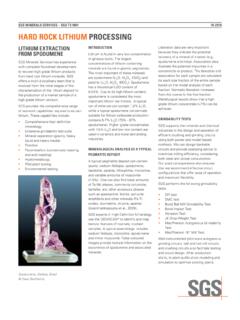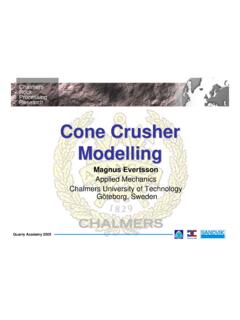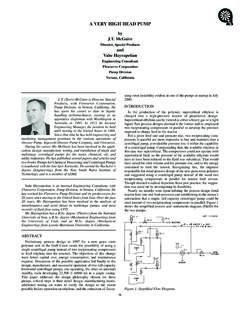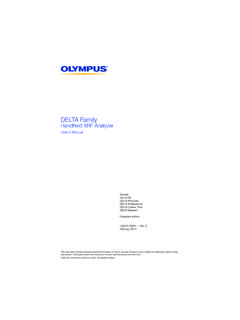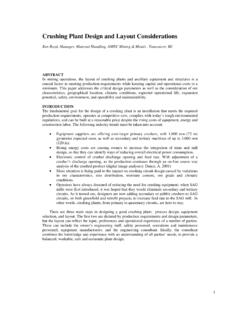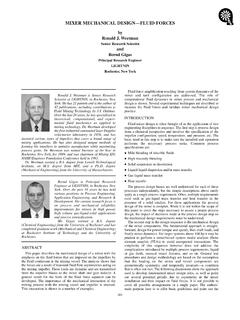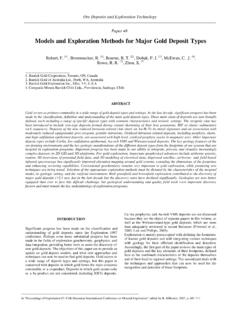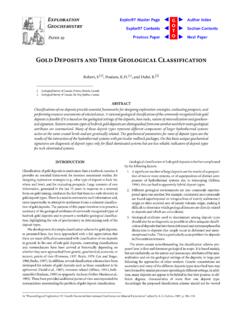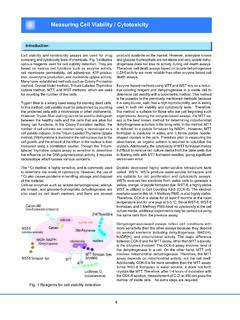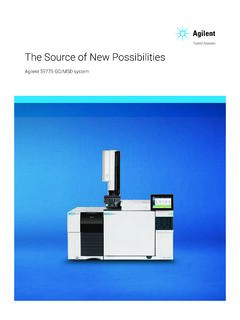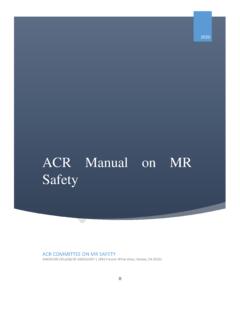Transcription of Principles of Screening and Sizing
1 Principles of Screening and SizingPresented By: George SchlemmerToday s Agenda Provide you with information to promote a safer, more cost efficient operation. Topics covered to include: Performance and carrying capacity. Review external factors (type of material, amount of near size in the material, shape of material). Review the screen Sizing formula and the effects that each of the above can have on the Sizing process. Review speed, stroke and slope. Media options available to today's producers and there applications. Troubleshooting guidelines and items to review at the quarry. To prepare a sized product. Screen Duties Take home message: Final product Duties Stratify the material. Prevent pegging. Prevent blinding. Separate the material into two or more fractions. Transport the material to provide the screen its carrying capacity!OversizeUndersizeFeedScreen PerformanceCarrying amount of material a Screening machine can carry over the decks before the momentum of the screen body is overcome by the weight of the Capacity Carrying Capacity - amount of material a vibratory screen can carry over the decks before the momentum of the screen body is overcome by the weight of the material.
2 Factors for carrying capacity calculations include:CARRYING CAPACITY = m x v x s2 x n2C x lCARRYING CAPACITY = CARRYING CAPACITY = m m xx v v xx ss22 xx nn22C x lC x lzm = moving mass in screen bodyzv = speed of material over the deckzs = stroke lengthzn = rotational speed (RPM)zl = length of screenzC = constant derived from performance data Application factors Material characteristics (Wet, dry, slivers, openings) Screen set-up Speed, stroke, slope, direction of rotation, etc. Feed rate (stph) and material bed depth Media Media type, open area, wire diameter, opening shapeInformation Required to Measure Screen Performance and Solve Problems Maintenance & Installation Natural frequency vs. operating frequency Tension on v-belts Correct installation of motor base(s) Springs Proper torque for all fastening hardware LevelFactors Which can Effect ScreeningSchemarubrik- Feed curve- Moisture content- Bulk density- Material type- Particle shape% half size% under sizeMaterial- Media materialHole shape/size- Open AreaMedia- Machine type- InclinationMovementSpeedThrowDirectionWi dth/lengthMachine- Separation size- Fraction length- Accuracy- Wet or Dry- CapacityDutyScreen areaHow Application Factors Affect Capacity and AccuracyApplication / modifying factors.
3 Half size in feed Higher % of half size increases capacity Oversize in feed Lower % of oversize increases capacity Wet Screening Increases capacity Slotted openings Increases capacity Finer wire diameter < open area Increases capacity & efficiency Reduce efficiency rate Increase capacity Moisture Reduces capacity & efficiency Elongated particle shape Reduces capacity & efficiency Near size material Reduces capacity & efficiencyDetermining Screen Capacity Each opening has a volumetric throughput capacity: Basic capacity figure is expressed as tph per Figure is multiplied by the sq. footage of the screen deck. Calculation gives the basic capacity of each deck and the total capacity of the vibrating screen. The vibrating screen capacity is determined: Using a standard Sizing formula (9 variables). Basic capacity of each deck opening. Unique factors of that application. Maximum bed depth allowed for the openings and particle Area CalculationBasic formula for calculating screen area (per deck) U: Required Screening area ( ) A: Nominal capacity for separation B: % Oversize (.)
4 33 ) C: % Halfsize (.40 ) D: Deck location (.80 ) Screening Area = U / (A x B x C x D x E x F x G x H x J) E: Wet Screening ( ) F: Material weight (.30 ) G: Open area of media H: Shape of opening ( ) sq-short-long L: Accuracy (.70 ) ApplicationExampleU: Required Screening area (Square feet)A: Nominal capacity for separationB: % Oversize (.33 )C: % Halfsize (.40 )D: Deck location (.80 )E: Wet Screening ( )F: Material weight (.30 ) : Open area of mediaH: Shape of opening ( ) sq-short-longL: Accuracy (.70 ) 8x20 = 160 per deckCommon Factors which can Reduce Capacity and Accuracy Basic capacity figure is based on two key factors: Feed with a maximum of 25% oversize Minimum of 40% half-size Basic capacity is modified: Increased or decreased based on the actual factors in each application. Material bed depth: At discharge end; should not be deeper than 4x the deck opening. Example: opening x 4 = 2 material bed depth.
5 If bed depth exceeds this ratio, accuracy is Width Screen width controls material bed depth which allows material stratification and separation to take place. Width = Capacity, Length = Accuracy Material bed depth gauge: Should not exceed 4x the deck opening at the discharge end. Ideally you should be able to see the last few feet of media. Feed rateWidthBulkdensityMaterial speedAccuracy defined: The degree of correctness of a quantity, expression, etc. Expressed as the ratio of allowable percentage of maximum oversize and undersize in the final product. 10/10, 10/20, 15 defined: The percentage of work done. Normally expressed as; 80%, 85%, 90%, 95% objective Screening efficiency, with no specific or defined reference to the allowable percentage of oversize or undersize in the Theory 3/8 nom 10%nom 10%True Screening Example Asep. sep. 3/8 0 3/8 ~3/8 3/4 ~3/4 2 opening opening 3/8 0 2 Fines in the coarse fractionTrue Screening Example Bsep.
6 Sep. 3/8 0 ~3/8 ~3/8 ~3/4 ~3/4 2 3/8 opening 7/8 opening 7/16 0 2 A larger hole size will provideless fines in the coarse fraction,but some oversize in the under flownom 15%nom 10%Accuracy demandScreening Theory Take home message: Accuracy of the fraction produced by the deck. A true representation of the real world limits in which screens operate and aggregate specifications are written. Max Over/UndersizeFactor: L10 Becomes easily fluid, helps stratification. Shorter distance for fine particles to sift down to the deck. Less pegging tendency, stones are not forced down. Can reduce accuracy. Overload the screen carrying bed depth is right for stratification? A thin bed: A thick bed:Which Bed Depth is Correct for Accuracy? (Discharge end) Maximum bed depth at discharge end is 4x the separation. If too thick, probability is decreased for sized aggregate to properly stratify and pass through an opening. Minimum bed depth is 1x the separation. If too thin, material can bounce, stay suspended and not stratify or find an opening, thus reducing Operation After correct screen size is selected, optimal performance results from appropriate operation.
7 Unit must be operated at the best combination of the below variables: Speed Stroke Slope Direction of rotationScreen Speed and Stroke in Combination with Deck OpeningszLarge openings = Large stroke and slower openings = Small stroke and higher speed. Speed = RPM (800 RPM). Stroke = Diameter of circular motion (.375 Diameter). Material is stratified, separated and SCREENS Stroke, Speed and Slope SelectionStroke (in.)Nominal Speed (RPM)Top Deck Opening35M 50M20M- 35M10M- 20M4M- 10M - 4M1 - 1/2 2 - 1 3 - 2 4 - 3 6 - 4 8 - 6 Above 8 Slope Range (degree)03350024-3005260024-3006210022-2 83/32180022-261/8160022-263/16140020-251 /4100018-255/1690018-253/885018-257/1675 018-251/2700 For dry 100 material and flow mechanism Screens and Feeders Stroke and Speed SelectionVibrating Feeders1/2 to 5/8 stroke is common, 700 800 RPMFor dry 100 material and flow mechanism Feeders Approximate CapacityRPM30 (.76 m) Wide36 (.91m) Wide42 ( ) Wide50 ( ) Wide60 ( ) WideTPHmt/hTPHmt/hTPHmt/hTPHmt/hTPHmt/h6 0082875465062356889881870031528747343167 1611967881750270246337307507462720656103 5943800290264360328541493767698850305278 3823485755249003252964043686095559503453 144273896425851000365332 Capacity multipliers for feeder pan mounting angles from 0 to 10 Angle Downhill0 2 4 6 8 10 Affecting Material SpeedInclinationMechanism speedStroke lengthScreening media typeMaterial sizeMaterial shapeMaterial build upCross damsSpeedGravity Free Fall = ft/second Gforce = RPM x Throw704182 Gforce = 800 x 7/16 = of Rotation With-flow rotation is always preferred.
8 (always consult manufacturer before reversing rotation) Counter-flow rotation can produce higher Screening accuracy, but can also limit overall capacity due to slower travel speed and high bed depth. Speed and Stroke Combination Summary Speed & stroke are interrelated and selected in standard combinations to offer optimum Screening . Speed is selected to help create a sufficient material travel rate to produce a shallow enough bed depth that allows the fines to sift through the material bed and screen out. Stroke is selected to be sufficient to prevent plugging but not so great that it affects the life of the frame, mechanism, screen media, or interferes with the Screening process. B10 Life = Minimum 10,000 MediaScreening Media Woven wire cloth Plastic (Monofilament) Piano wire Rod deck Grizzly bar Louvered deck Profile deck Polyurethane(PU) Rubber Perforated plate Cast plate deck Rubber clad perforated plateScreening Media Woven Wire Woven wire cloth - openings Square (clear opening / mesh)
9 Long slot Short slot Z slot S slot L slotScreening Media Woven Wire Woven wire cloth - weave Plain weave Semi-crimp Double crimp Press lock crimp Intermediate crimp Flat top weave Press crimpScreening Media Woven Wire Material Stainless steel alloys Heat resistant alloys Copper alloys Aluminum Nickel alloys High carbon steel Oil temperedScreening Media Woven Wire Hook strips Hooked edge 45 Single reinforcing Square Welded insert Welded square bar U-hook stripScreening Media Woven Wire Hook strips Double reinforced Welded insert Knuckled Edge Welded edge wire Folded hook strip 90 Welded plate Taped Installation Check installation of clamp railMedia length and hookAlignment - open areaProper alignment of media hook stripScreening Media PUA modular Screening media for fine to medium coarse Screening in wet Media RubberA modular Screening media for fine to medium coarse Screening in dry Media Rubber (40 Duro)A modular Screening media of soft rubber for fine Screening in difficult Media Synthetic PU or RubberTensioned PU or rubber Screening media for fine to medium coarse Screening in wet or dry Media Selection GuideWear Protection in the Feed Box, Discharge Lips and Side Liners AR steel Steel-backed rubber PU CeramicsWear Protection for Feeders and Hoppers AR steel Mild Steel Rubber and steel backed rubber Cast or fabricated grizzly bars Safety Good neighbor Sound DustOptions: Dust Encapsulation Wash clean spec stone Stationary or live mounted Rule of thumb: 4-6 gpm / ton of feedOptions: Spray SystemOptions Base Frame Media Cardan shaft drive Liners Motor(s) Special paint or coating Steel to Improving Screen Performance Identify the improvement you want or determine the problem that you have with your vibrating screen.
10 Examples: Increase tph, improve screen efficiency, cleaner product, reduce re-circulating If you have a new problem, determine if something has changed in the circuit, material characteristics, crusher setting, screen opening, screen speed and stroke. Gather specific application data as it applies to that unit and seek assistance from the manufacturer or Plugging and Blinding with Speed & Stroke Make sure you have the correct speed & stroke for the openings. There is normally a speed & stroke adjustment which can be made to help. For plugging, increasing the stroke normally helps to kick out the near size or elongated material. For blinding, increasing the speed normally helps and sometimes increasing the stroke also helps. Sometimes blinding problems start out as plugging consult with the factory before making any changes!Determining Speed & StrokeSpeed: Electronic RPM MeterORDrive sheave dia. divided by driven sheave x motor :Motor sheave 5 , Screen sheave 11 , Motor RPM 17505 divided by 11 =.
